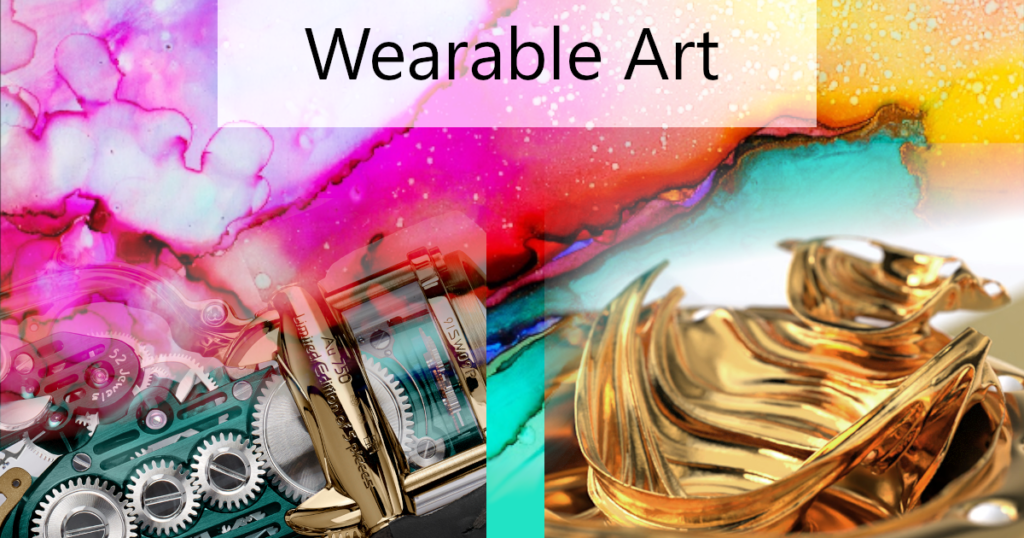
The above image shows our Fractal Emergence watch, lower right.
Sections of this article:
- What Is Wearable Art?
- The History Of Wearable Art
- Famous Artists Who Made Wearable Art
- Why Some “wearable Art” Is Not Really Art
- Jewellery As Wearable Art
- Watches As Wearable Art
- Are UnconstrainedTime Watches, Wearable Art?
Introduction. As usual, I look at the concepts behind the subject . . . what is art and what, exactly, is wearable art, as well as presenting some interesting examples in clothing, jewellery, and watchmaking. I also look into reasons why some things called “wearable art” are not really art, giving you the understanding you need to think for yourself on the subject, then I assess if our own brand is wearable art.
What Is Wearable Art?
What is art? . . . art is creativity relating to conceptual ideas used as a means to communicate, evoke emotions and present challenging perspectives and concepts. It is enjoyed for its own sake, not for its practical usefulness as one would with design. Art has special focus . . . it presents something as being worthy of unusual attention, unlike most of the experience of everyday life. And art is a personal exploration beyond one’s current reality.
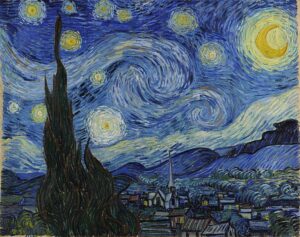
Art is unique (a copy of art is not art, although a limited edition of art prints can be), is focused on aesthetics, and is personal . . . it is, to a significant degree, about the person who created it.
On the other hand, some pieces of fine art are actually made by others (which overlaps with the fine art concept of the “found object” which can be natural rather than man-made), with the art being in the creation of the unique concept more than the physical act of making it. Examples include Roy Lichtenstein’s fine art:

. . . which was made from enlarged pieces of comic books and advertisements, Damien Hirst’s shark which was pickled by someone else, and many of the great artists throughout history who’ve had parts of their paintings made by others.
Wearable art is individually made or released as a small limited edition, and intentionally created as art. Its influences are concepts and perspectives from the fine art world, and it is not about fashion trends or even necessarily wearability.
It typically consists of outstanding pieces, many of which are more at home on a catwalk than in everyday life:
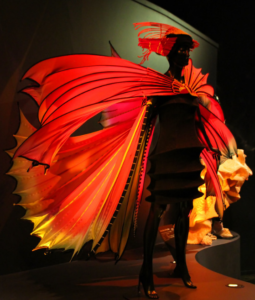
Even when they are pieces which could be realistically worn in an everyday life setting, they are still typically outstanding and unique. The definition of art includes it having a special focus, so to be genuine wearable art, an item would need to be, to most observers, something deserving a lot more attention than other clothing. Which means wearable art often works as a conversation starter, and communicates something about the choices of the wearer, their uniqueness, individuality and self-expression.
While the concept was originally applied mainly to clothing and jewellery, it is more recently being applied to watches, although, as we’ll see below, that is sometimes more about marketing than reality. The term aligns with art jewellery in that wearable art often uses a wider range of materials than conventional garments, such as sometimes incorporating found items or electronics.
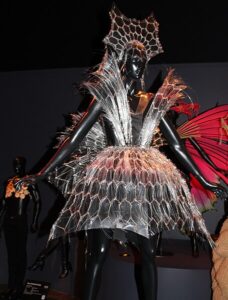
Like fine art, wearable art often focuses on a concept or story and often challenges conventions. Unlike fine art, while often shown in galleries, it also brings art into the street.
The History Of Wearable Art.
The origins of wearable art can be traced to the early twentieth century American Craft Revival which draws on different movements seeking to unify art and craft.
While movements like this certainly resulted in collaborations and valuable cross-fertilizations between the different areas of artisan/craft, design, and art, in reality these terms have different definitions, and cannot really be “unified” except by ignoring their real definitions, which is often done intentionally by marketing, as we’ll see below.
In the 20th century artists and designers explored avant-garde concepts that went beyond the confines of traditional fashion. In the 1920s, artists like Sonia Delaunay (below) and the Bauhaus movement experimented with geometric patterns and bold colours, turning clothing into wearable canvases for abstract art.
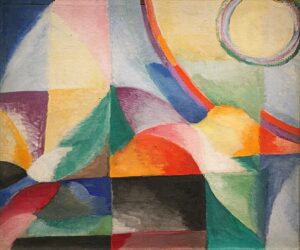
The wearable art movement was significant in jewellery between 1930 and 1960, then becoming more significant in clothing from the ’60’s but relating back to the arts and crafts movement of the 1850’s in terms of seeking to integrate art in everyday life and objects, although the term itself didn’t see much use until 1975, being used alongside “Artwear” and “Art to Wear.”
The 1960s and 1970s witnessed a surge in counter-cultural movements, bringing about a revolution in the perception of fashion and art. The psychedelic and hippie movements embraced unconventional materials and home-made aesthetics, giving rise to a wave of wearable art that challenged mainstream fashion norms.
The term “wearable art” gained prominence in the 1970s as artists sought to break free from the commercial constraints of the fashion industry. Notable figures like Yoko Ono, who collaborated with designer Kaisik Wong to create avant-garde fashion pieces, and the Fluxus movement, known for its interdisciplinary approach to art, and its attempt to bring art to the masses by destroying any boundary between art and life, played pivotal roles in shaping the wearable art movement.
The 1990’s allowed customization at scale, which decreased the focus on wearable art, with many artists tending to focus on the high end of the market rather than creating art for its own sake.
In the ensuing decades, wearable art continued to evolve, with artists exploring diverse mediums, materials, and technologies. The advent of the internet and social media further democratized the genre, enabling artists to showcase their creations to a global audience without the need for traditional gatekeepers.
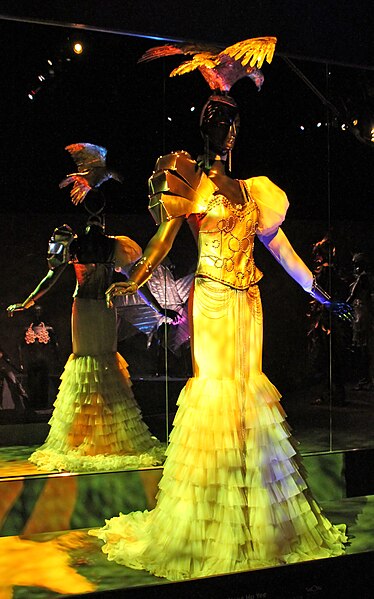
Today, wearable art stands as a vibrant and dynamic form of artistic expression, with artists from various disciplines pushing the boundaries of what can be considered wearable. From high-profile fashion designers incorporating art into their collections to independent artists creating one-of-a-kind pieces, the history of wearable art is a testament to the enduring human desire to merge creativity with the everyday act of getting dressed.
Famous Artists Who Made Wearable Art
Several famous artists have made significant contributions to the realm of wearable art, pushing the boundaries of traditional fashion and transforming clothing into unique and expressive pieces. Some of these can be seen as an artist working in the mediums of clothing or jewellery, others might more clearly be seen as collaborations between artists and brands that make wearables.
One such artist is Yayoi Kusama, a Japanese contemporary artist known for her avant-garde installations and vibrant polka-dot patterns. Kusama’s collaboration with fashion brands, including Louis Vuitton, resulted in the creation of clothing and accessories that mirror the bold and eccentric aesthetic present in her visual artworks:

Matisse created a series of colourful chasubles, which is the outer garment worn by a Catholic priest while celebrating the Mass.
Another notable figure is Salvador Dalí, the surrealist painter, who ventured into the world of fashion through collaborations with designers like Elsa Schiaparelli. One iconic piece is the “Lobster Dress” (below) created in 1937, featuring a printed lobster prominently displayed across the front. Another of their creations was “Hat” , inspired by a photograph of Dalí wearing a shoe on his head.
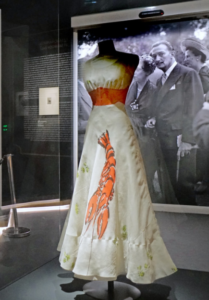
Moving into the contemporary art scene, renowned sculptor and installation artist Nick Cave is celebrated for his elaborate and fantastical “Soundsuits.” Originally created as a response to the 1991 Rodney King beating, with the first one using twigs to create a layer of armour that makes noise as the wearer moves, these wearable sculptures are composed of a myriad of found objects, including buttons, beads, and fabric, covering the body to obscure identifying aspects of the person wearing them. The Soundsuits serve both as artistic expressions and functional garments, blurring the lines between sculpture, performance, and fashion:
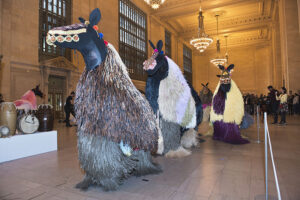
In the realm of performance art and music, the eccentric costumes of David Bowie, designed by Kansai Yamamoto, are iconic examples of wearable art. Bowie’s alter ego Ziggy Stardust featured flamboyant and futuristic outfits that became synonymous with the glam rock era, illustrating the symbiotic relationship between music, visual arts, and fashion:
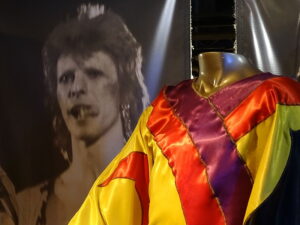
Contemporary fashion designer Iris van Herpen seamlessly fuses technology and haute couture in her creations, often described as wearable sculptures. Her innovative use of 3D printing and unconventional materials results in garments that defy traditional notions of form and structure, reflecting an intersection of craftsmanship, technology, and artistic expression:
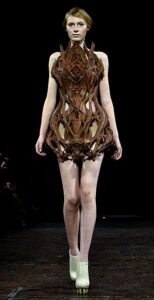
These examples highlight how renowned artists from various periods and disciplines have embraced the concept of wearable art, leaving an indelible mark on the intersection of fashion and fine art. Through their innovative approaches, these creators have elevated clothing and accessories to the status of wearable masterpieces, contributing to the ever-evolving landscape of artistic expression.
Why Some “wearable Art” Is Not Really Art
One factor is that people either don’t understand the real definitions of things like the difference between art and design, or deliberately mis-define such things in various ways. We’ve seen an example of this before in terms of the arts and crafts movement trying to “unify” art and craft which are, in reality, two different things, by ignoring the real definitions.
The other main factor is that marketing can make products more appealing by convincing people they are something which they’re not, such as calling something “art” when it doesn’t fit the definition of the word.
For example, there are articles about watches which say they are made by craftsmen or artisans, and then describe them as “art” in the same sentence, which is a clear contradiction, since art and craft are different things. Other examples include statements that an item is “art” because of its exceptional craftsmanship, which ignores the different definitions of art and craft.
Another example is a watch which includes miniature copies of famous Van Gogh paintings. While that’s obviously done by an extremely skilful artisan, it’s still a copy of someone else’s art, rather than including the unique personal exploration of something genuinely new that defines something as being art in its own right. To me, the technical exercise in making such copies of other people’s work very much smaller, while impressive, is not nearly enough to make them art. Nearly all reproductions of artworks, such as having them printed in books or shown on screens, makes them smaller, but it doesn’t define them as new artworks . . . they are still just copies, as they are if someone else paints an indistinguishable copy of an original artwork.
Also, like most areas of creativity, the more significant wearable art influences others to produce less extreme versions with somewhat more mass market appeal, marketed as if they are as significant and unique as the more original artworks.
As I mentioned above, the physical act of making something is not what makes that object art, it’s the concepts which are a personal exploration by the artist, even if the practical making of the object is done by others. On the other hand, something designed by a team, however beautiful and unusual it is, is not really art, since it is not really personal.
Jewellery As Wearable Art.
Fine jewellery is very rarely genuine art. Some art jewellery is art, and some art jewellery is artisan craft or design work.
Here are some examples of recent art jewellery:
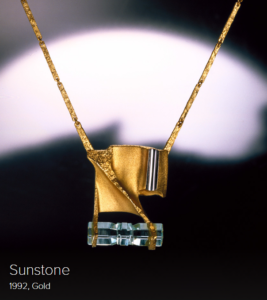
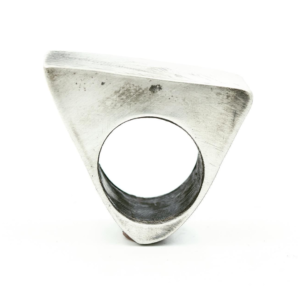
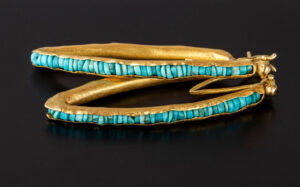
Comparison of fine jewellery with art jewellery:
| Fine Jewellery: | Art Jewellery: |
| materials: precious metals, precious gemstones | can include any material |
| simple symbolized forms | can include complex forms (organic, broken, fractal etc.) |
| highly polished surfaces | surfaces can be complex, rough, organic, broken, fractal etc. |
| design | some sub-categories (including conceptual-art-jewellery) are art |
| symbolized, polished, decorated & decorative | can use materials, forms and surfaces as what they are |
| valued by materials and brand | valued as art |
Jewellery was used by surrealists, cubists, abstract expressionists, and other modernist artists working around the middle of the 20th century, creating genuine artworks in that medium. The art jewellery movement, championed by artists like Alexander Calder and Art Smith around this time, emphasized the individuality and artistic expression that were possible in the field of jewellery design.
One writer said that the only difference between sculpture (which has been an accepted fine art medium since the beginning) and art jewellery is the size, although the term “wearable sculpture” is not popular currently.
Artists have elevated jewellery to the status of wearable art through innovative designs, unconventional materials, and conceptual exploration.
One example is the “Boucheron Question Mark Necklace” created by renowned jeweller René Boivin in collaboration with Jeanne Boivin in the 1930s. This avant-garde necklace, shaped like a question mark, challenged traditional jewellery norms with its bold design and novel concept.
Contemporary jewellery designer Wallace Chan is celebrated for his ground-breaking creations that blur the lines between sculpture and wearable adornments. Chan’s intricate pieces often feature rare gemstones, innovative carving techniques, and three-dimensional designs, such as birds, turning each creation into a wearable masterpiece.
An example of a fine artist working in jewellery is the Damien Hirst “Pill” Jewellery Collection, consisting of jewellery cast in the form of pills and embossed with the logos and details of various drugs.
Using avant-garde shapes, unconventional materials, or a fusion of traditional craftsmanship and modern innovation, jewellery as wearable art invites individuals to carry a piece of artistic expression with them, making a bold statement about both personal style and appreciation for unique artworks.
Watches As Wearable Art
Some timepieces are meticulously crafted with attention to design, materials, and intricate detailing, transforming them into outstanding pieces that adorn the wrist with great beauty and elegance.
An important part of the definition of art is the concept of a special focus. According to Ben Dutton, in “What Makes Art Art?”, all art is “bracketed off from ordinary life, made a separate and dramatic focus of experience. In every known culture, art involves what the art theorist Ellen Dissanayake calls ‘making special.’“
This is, very obviously, dependent on the context it is presented and/or seen from. For example, the work ‘Fountain’, by Marcel Duchamp, which is a standard urinal, would be design if it was used as a urinal, but is art when presented in an art gallery. No-one would be paying the same degree of attention to that object in its natural habitat, as they do when it is in an art gallery. Even if some people disagree that it’s art, that significant intellectual and emotional act of disagreement about a concept, which would not happen seeing that exact same object in its usual context, makes that piece art, since part of the definition of art is something which presents challenging concepts and has a special focus.
Another important part of the difference between art and design is that art is personal, it is about the artist. With design, someone different (or an AI) could have designed something very similar, and it would have just as much significance, but with art, it matters who created it. For example, there are a few people who can reproduce the exact style of a great artist, so that only an expert could determine whether it was by the great artist or not. But such imitations will never have the same artistic standing as original pieces by the great artist, even when the piece is somewhat original in content.
With these concepts of special focus and art being personal, in mind, one can see that some of the watches which are labelled as “wearable art” are, in reality, much closer to design or artisanal work (which is also classified as design), than they are to being art.
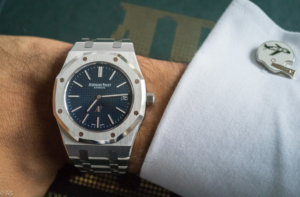
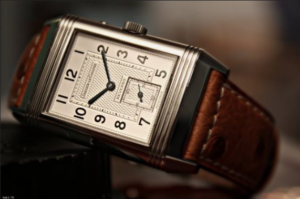
Examples include the Audemars Piguet Royal Oak (above left) and the Jaeger-LeCoultre Reverso (above right). Both of those iconic watches were significant pieces of great design work when they were created, but, unless you are a watch expert, wearing one today would not result in most people giving them much special focus of attention. And, while any excellent example of design work is likely to reflect some degree of the personal choices of the designer, in my opinion that’s not enough expression of individuality to make it art.
There are plenty of beautiful, impressive and unusual watches that would get special focus, today, because of the way their innovative design stands out from the typical aesthetics of most watches. Here are a few examples:
The H. Moser & Cie x MB&F Endeavor Cylindrical Tourbillon:
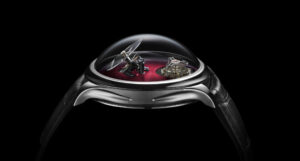
. . . the result of a collaboration between the two watchmakers, is designed more three-dimensionally than most watches, featuring hour and minute hands standing upright, as well as a cylindrical tourbillon. It is one of the most unique looking watches ever made.
The HM9 Sapphire Vision from MB&F:
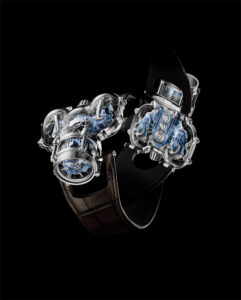
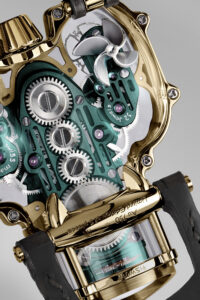
. . . is visually extraordinary as well as being technically impressive, and was made available to the public in four limited editions, with just five pieces each. Made as “a tribute to the extraordinary automotive and aeronautic designs of the 1940s and 50s. The result was a case like no other that echoed the epoch’s flowing, aerodynamic lines.“
They decided to present their amazing and beautiful movement encased in “an outer hull of sapphire crystal and precious metal.” An outstanding example of creative watch design.
Very distinctive Urwerk watches:
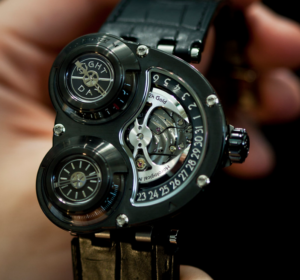
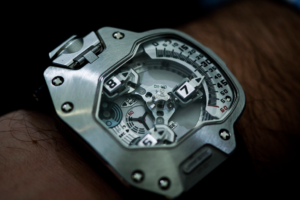
The Urwerk website includes many examples of their amazingly creative and unique watches, using impressive feats of innovative engineering as fascinating aesthetically stunning creations.
While those examples above are obviously creative, undeniably stunning aesthetically, and are obviously going to garner special focus, whether they are art is debatable . . . do they really say so much about the creator that they are personal enough to be described as art? In my opinion, some unusual watches do, and some don’t . . . I’d rather you think for yourself, given the background understanding I’ve given you in this article, and really look at such examples for yourself, than either agreeing or disagreeing with my opinion on the matter.
Are UnconstrainedTime Watches Wearable Art?
Our sculptures/watches are certainly focused on aesthetics for their own sake, rather than being based on functionality, and are unique and individual enough to be a definite special focus.
Our initial range of watches, all created by myself, are very much a personal exploration into stories and concepts, and relate to my personal artistic obsessions, as well as working with our simple time-display, which links to the beginnings of horology, as an integral part of the whole.
Our watches are not, like many collaborations between an artist and a watchmaker, some art added to an otherwise conventional watch . . . with UnconstrainedTime the whole watch is the art, and the art is the watch.
Our pieces are also part of the conceptual-art-jewellery space (which is art) rather than being based on engineering or fine jewellery which are both design.
And they are wearable. Which seems to me to qualify them as wearable art. What do you think? . . .
We’d love to know your opinions, in the comments below or on our social media.
And . . . don’t miss our launch! . . . subscribe here for notifications.
Author: Chris Melchior

This article was authored by Chris Melchior, founder of UnconstrainedTime and creator of the original range of wrist-worn sculptures of this unique artistic adventure.
Chris has extensive knowledge and experience of creativity, including fine art and cutting-edge contemporary music composition, and was awarded a First Class Honours Degree in fine art and music with a minor in philosophy.
Chris’s life-long artistic obsessions include organic forms and textures, abstraction, fractals, and the aesthetic essence of musical genres.
He has developed unusually deep insights into the elemental concepts underlying areas including Eastern and Western philosophies, science and technology, creativity and the arts, as well as empirical spirituality in which he is acknowledged as a leading authority.
He has a profound fascination and love for the unique and synergistically creative combination of fine art with the ancient essence of time-keeping which evolved into the UnconstrainedTime project.

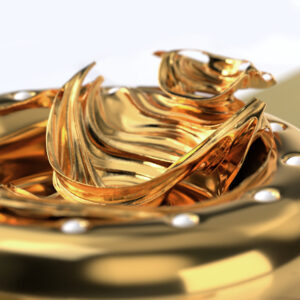
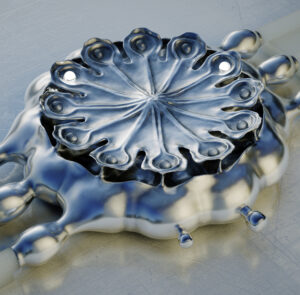
Leave a Reply